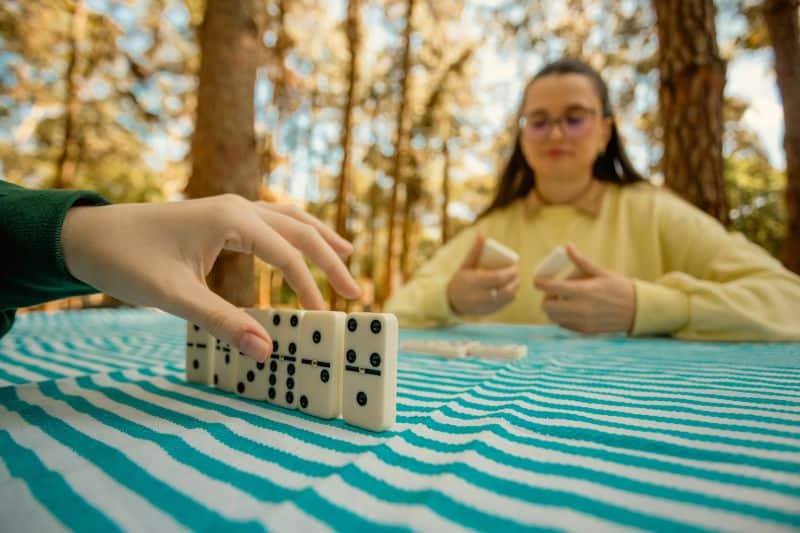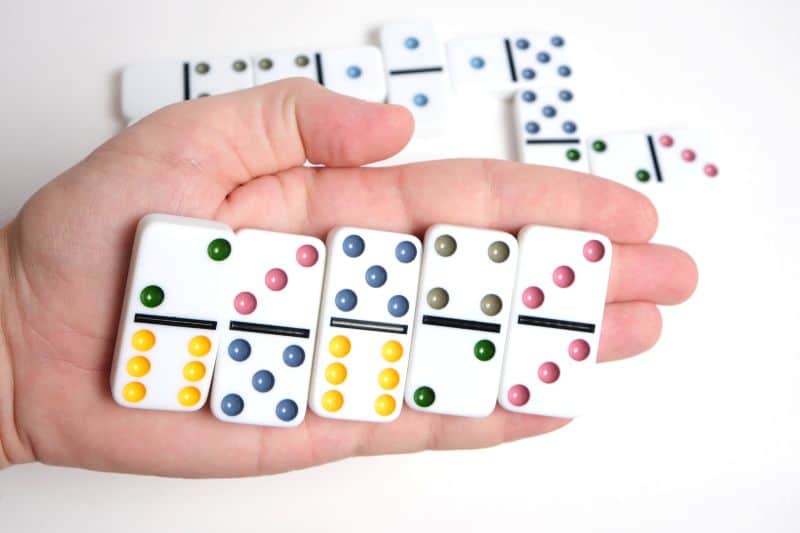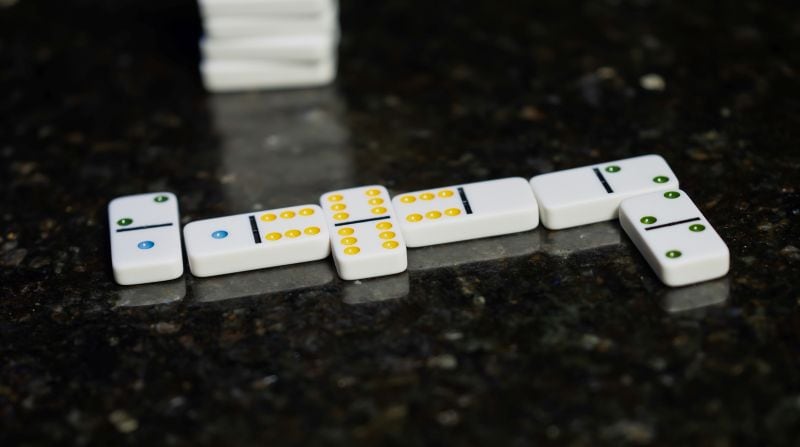We love to play games while camping and dominoes are a fun addition to our repertoire.

You’ve finally arrived, the campsite is all set up, and you’re ready to unwind and soak in the fresh air. But then—it starts to rain. Or your child can’t find a playmate. That’s when you hear those familiar, dreaded words: “I’m bored! There’s nothing to do… and no one to play with!”
We love being a one-child family, but there are times when our son doesn’t quite see the benefits. Without a sibling to play with, he sometimes feels the absence of a built-in companion. And when the dog’s had enough and solo play has lost its charm, it’s the perfect moment to pull out the dominoes and dive into a game together!
Please note that this article contains affiliate links, and we may earn commissions from qualifying purchases made through links in this post. You can read our full disclosure on our disclosure page.
We don’t like to bring along complex games to the campsite. What if we lose pieces? The board might get damaged. This mama’s brain might forget how to play (and doesn’t really want to read instructions while relaxing). But a tin of dominoes (double nine) is a different story. They don’t take up a lot of space. There are multiple games to play. And many of these can be played with just two or three people, perfect for our small family.
Playing dominoes with kids offers a wide range of benefits—it’s more than just fun! Here are some great reasons to include dominoes in your family game time:
- It builds math skills.
- Counting dots, matching numbers, and simple addition help strengthen number sense.
- Introduces concepts like greater than/less than and multiples in a hands-on way.
- Boosts logical thinking and strategy.
- Encourages pattern recognition, problem solving, and planning ahead.
- Kids learn to think through their moves and anticipate others’ moves.
- Supports social and emotional growth.
- Practicing taking turns, winning and losing gracefully, and working together.
- Helps build patience, focus, and resilience.
- Improves fine motor skills.
- Picking up and placing dominoes helps develop hand-eye coordination and dexterity.
- Encourages quality family time.
- Dominoes are simple to learn and play across generations.
- It creates opportunities for connection, conversation, and shared laughter.
- Fuels creativity and exploration.
- Kids can explore new ways to play, setting up domino runs, inventing rules, or creating domino art.
- It turns into open-ended play with endless variations.

Some Common Domino Terms:
- Bones: Refers to the dominoes themselves.
- Boneyard: The group of dominoes that are not dealt out at the beginning of the game.
- Hand: The dominoes held by a player.
- Pips: The dots on the dominoes.
- Double/Doublet: A domino with the same number on both ends.
- Spinner: The first double played in a game.
- Honey Bone: A domino that can be played on the spinner, often with a blank or five on the other end.
- Washing Dishes/Bust Them Suds: Shuffling the dominoes.
- Knock/Pass: To end your turn without playing a domino, often because you have no matching tiles.
- Domino: When a player plays their last domino.
- Dominoed Out: When a player plays the last tile in their hand.
- Block: When no player can make a play and the game ends.
- Heavy/Lighter: Terms used to describe the number of pips on a domino, with “heavier” meaning more pips.
- Set/Down/Lead: Terms for the act of playing the first tile.
- Lay Piece/Lay Suit: Terms related to playing a domino that matches a specific suit in the layout.
Our Favorite Kid Friendly Domino Games:
In (mostly) alphabetical order here are eight of our favorite kid friendly domino games to play while camping.
Block
GOAL: Be the first to play all your tiles or have the fewest dots left.
SETUP: Each player picks 7 tiles (or 5 for lots of players). Highest double starts.
INSTRUCTIONS: Take turns matching one end of a tile to an open end on the table. – Can’t play? Pass. No drawing. Game ends when a player runs out or no one can move.
SCORING: Add up dots in your hand. Lowest score wins!
WHY WE LOVE IT: Simple rules, good for beginners.
Draw
GOAL: Like Block, but you draw tiles if you’re stuck.
SETUP: Same as Block.
INSTRUCTIONS: Match one end of your tile to the board. – Can’t play? Draw 1 tile from the boneyard. – Still stuck? Pass. Game ends when a player runs out or no one can move.
SCORING: Count dots left. Lowest total wins!
WHY WE LOVE IT: Keeps players engaged longer and adds a bit of suspense.
Five-Up (aka Muggins)
GOAL: Score points by making the open ends total a multiple of 5.
SETUP: Each player draws 5-7 tiles. – Start with any tile or a double.
INSTRUCTIONS: Match tiles as usual. – After each play, add up the open ends. If it’s 5, 10, 15, etc., score those points!
SCORING: Add up scored points during the game. Highest score wins!
WHY WE LOVE IT: Introduces addition and multiples in a fun, competitive way.
Sniff
GOAL: Be the first to play all your tiles, with special double rules.
SETUP: Like Block/Draw, but first tile must be a double. – No double? Everyone draws one tile at a time until one is found.
INSTRUCTIONS: Match ends like usual. – When a double is played, some rules say it must be followed immediately.
SCORING: Count dots left. Lowest total wins!
WHY WE LOVE IT: Adds a fun twist and decision-making layer.
War
GOAL: Win rounds by playing the tile with the most dots!
SETUP: Everyone draws 5-7 tiles.
INSTRUCTIONS: Each player picks 1 tile and plays it face up. – The tile with the highest dot total wins the round! – Ties? Play again!
SCORING: Most round wins = game winner! Great for younger kids!
WHY WE LOVE IT: Fast-paced and great for younger kids learning number comparisons.
Chicken Foot
GOAL: Get rid of all your tiles and have the lowest score.
SETUP: Use a double-12 set. – Each player draws 7 tiles (or 5 for more players). – Find the highest double to start (like 12-12). Place it in the center.
INSTRUCTIONS:
Start the Chicken Foot: Everyone must play a tile that matches the center double. You need 3 to complete the chicken foot shape (like a Y).
After that, players take turns matching tiles to open ends.
Play a double? Say “Chicken Foot!” and now 3 more of that number must be played before anyone can go elsewhere.
Can’t play? Draw 1 tile. Still stuck? Pass.
End the round when someone runs out of tiles or no one can play.
Start a new round with the next double and continue rounds until all doubles have been played or you run out of time.
SCORING: Add up dots on leftover tiles. Lowest score wins!
WHY WE LOVE IT: Similar to the more well-known Train, this is a fun variation.
Train
GOAL: Get rid of all your dominoes by building your own “train” and possibly adding to others’.
SETUP: Use a double-12 set. – Each player draws 15 (2-4 players), 12 (5-6), or 10 tiles (7-8). – Place the highest double in the center.
INSTRUCTIONS:
Everyone builds their own “train” from the center using matching tiles.
Can’t play? Draw 1. Still can’t? Mark your train open with a coin. Others can play on it.
Start a public train (the “Mexican Train”) that anyone can play on.
Play one tile per turn unless you play a double-then go again!
Doubles must be covered before play continues elsewhere.
End the round when someone runs out of tiles or no one can play.
Start a new round with the next double and continue rounds until all doubles have been played or you run out of time.
SCORING: Add dots on leftover tiles. Lowest score at end of all rounds wins!
WHY WE LOVE IT: More complex and interactive, great for older kids or family game night.
Toppling
GOAL: Not a game in the traditional sense, but a creative challenge!
INSTRUCTIONS: Set up dominoes in a line or pattern and watch them fall.
WHY WE LOVE IT: Encourages creativity, planning, and fine motor skills.

FAQ about Dominoes and Domino Games:
Q. What age is appropriate to start playing dominoes with kids?
A. Ages 3 and up can begin with simple matching games using domino tiles. By age 5-6, most kids can play basic rule-based games like Block or Draw Dominoes.
Q. What skills do kids learn from playing dominoes?
A. They learn a variety of skills from playing dominoes. The most common ones are:
- Math skills: counting, number recognition, addition, multiples
- Logical thinking: problem-solving, strategy, planning ahead
- Social skills: turn-taking, communication, good sportsmanship
- Motor skills: hand-eye coordination, dexterity
Q. Do we need a special domino set for kids?
A. Not necessarily! Standard double-six dominoes work well. However, larger, colorful, or picture-based domino sets can be helpful for younger children. Having said that, the specialty sets for Train might be worth it, especially as they can be used for all of the games we suggest here.
Q. What is the difference between a double-six and other sets?
A. A double-six set has tiles with numbers from 0 to 6, while a double-nine set goes up to 9, a double-twelve set goes up to 12, etc. Larger sets allow for more players and longer games.
Q. How many players can play dominoes at once?
A. 2 to 4 players are typical for double-six sets, up to 8 players can join in with double-nine or double-twelve sets.
Q. How long does a game usually take?
A. Simple games like Block or Draw take around 10–20 minutes while more complex games like Train will last 30–60 minutes.
Q. What if my child gets bored or frustrated easily?
A. Try some of the following:
- Shorter games or time limits
- Team play with an adult and child together
- Domino toppling or creative play as a break
- Visual aids or scorekeeping charts to make progress easier to follow
Q. What’s the best way to introduce dominoes to a first-time player?
A. Start with simple matching games, explain and demonstrate using open hands, focus on fun over competition, and let kids help with shuffling and building the line.
Games are the perfect way to laugh, relax, and bond—whether you’re under the open sky or huddled inside when the rain crashes the camping party.
A tin of dominoes is an easy addition to your “I’m bored” tote of activities and we hope that we have shown you why we always keep one available. They won’t blow away in the wind and if they get rained on, they are easy to wipe dry. And this is why we bring them along with a deck of cards and some dice.
For other games we like to play while camping, check out our favorite (and sometimes educational) dice games using standard D-6 dice as well as our favorite card games using a traditional deck of cards.
If you have other domino games to suggest, please tag us on Instagram @campinganswer and tell us about them. We are always looking for new games to play.
